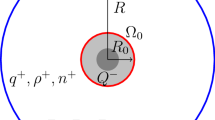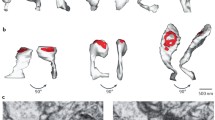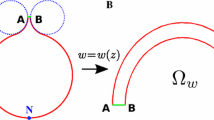Abstract
We study here the bulk electro-diffusion properties of micro- and nanodomains containing a cusp-shaped structure in three-dimensions when the cation concentration dominates over the anions. To determine the consequences on the voltage distribution, we use the steady-state Poisson–Nernst–Planck equation with an integral constraint for the number of charges. A non-homogeneous Neumann boundary condition is imposed on the boundary. We construct an asymptotic approximation for certain surface charge distribution that agree with numerical simulations. Finally, we analyze the consequences of several piecewise constant non-homogeneous surface charge densities, motivated by designing new nanopipettes. To conclude, when electro-neutrality is broken at the scale of hundreds of nanometers, the geometry of cusp-shaped domains influences the voltage profile, specifically inside the cusp structure. The main results are summarized in the form of new three-dimensional electrostatic laws for non-electroneutral electrolytes. These formula provide a refined characterization of voltage distribution at steady-state in neuronal microdomains such as dendritic spines, but can also be used to design nanometric patch-pipettes.







Similar content being viewed by others
References
Bezanilla F (2008) How membrane proteins sense voltage. Nat Rev Mol Cell Biol 9(4):323
Bourne JN, Harris KM (2008) Balancing structure and function at hippocampal dendritic spines. Annu Rev Neurosci 31:47–67
Cartailler J, Schuss Z, Holcman D (2017a) Analysis of the Poisson–Nernst–Planck equation in a ball for modeling the voltage–current relation in neurobiological microdomains. Phys D Nonlinear Phenom 339:39–48
Cartailler J, Schuss Z, Holcman D (2017b) Geometrical effects on nonlinear electrodiffusion in cell physiology. J Nonlinear Sci 27(6):1971–2000
Cartailler J, Schuss Z, Holcman D (2017c) Electrostatics of non-neutral biological microdomains. Sci Rep 7(1):11269
Cartailler J, Kwon T, Yuste R, Holcman D (2018) Deconvolution of voltage sensor time series and electro-diffusion modeling reveal the role of spine geometry in controlling synaptic strength. Neuron 97(5):1126–1136
Delgado MI, Ward MJ, Coombs D (2015) Conditional mean first passage times to small traps in a 3-D domain with a sticky boundary: applications to T cell searching behavior in lymph nodes. Multiscale Model Simul 13(4):1224–1258
Henrici P (1974) Applied and computational complex analysis, volume 1: power series, integration, conformal mapping, location of zeros. Wiley, Hoboken
Hille B et al (2001) Ion channels of excitable membranes, vol 507. Sinauer, Sunderland
Holcman D, Schuss Z (2012) Brownian motion in dire straits. Multiscale Model Simul 10(4):1204–1231
Holcman D, Schuss Z (2015) Stochastic narrow escape in molecular and cellular biology: analysis and applications. Springer, New York
Holcman D, Yuste R (2015) The new nanophysiology: regulation of ionic flow in neuronal subcompartments. Nat Rev Neurosci 16(11):685
Huckel E, Debye P (1923) Zur theorie der elektrolyte. i. gefrierpunktserniedrigung und verwandte erscheinungen. Phys Z. 24:185
Jayant K, Hirtz JJ, Jen-La Plante I, Tsai DM, De Boer WD, Semonche A, Peterka DS, Owen JS, Sahin O, Shepard KL et al (2017) Targeted intracellular voltage recordings from dendritic spines using quantum-dot-coated nanopipettes. Nat Nanotechnol 12(4):335
Jayant K, Wenzel M, Bando Y, Hamm JP, Mandriota N, Rabinowitz JH, Jen-La Plante I, Owen JS, Sahin O, Shepard KL et al (2019) Flexible nanopipettes for minimally invasive intracellular electrophysiology in vivo. Cell Rep 26(1):266–278
Koch C, Segev I (1989) Methods in neuronal modeling: from synapses to networks. MIT Press, Cambridge
Lan W-J, Edwards MA, Luo L, Perera RT, Wu X, Martin CR, White HS (2016) Voltage-rectified current and fluid flow in conical nanopores. Acc Chem Res 49(11):2605–2613
Lindsay AE, Bernoff AJ, Ward MJ (2017) First passage statistics for the capture of a Brownian particle by a structured spherical target with multiple surface traps. Multiscale Model Simul 15(1):74–109
Perry D, Momotenko D, Lazenby RA, Kang M, Unwin PR (2016) Characterization of nanopipettes. Anal Chem 88(10):5523–5530
Pillay S, Ward MJ, Peirce A, Kolokolnikov T (2010) An asymptotic analysis of the mean first passage time for narrow escape problems: part I: two-dimensional domains. Multiscale Model Simul 8(3):803–835
Qian N, Sejnowski T (1989) An electro-diffusion model for computing membrane potentials and ionic concentrations in branching dendrites, spines and axons. Biol Cybern 62(1):1–15
Schuss Z (2015) Brownian dynamics at boundaries and interfaces. Springer, Berlin
Schuss Z, Nadler B, Eisenberg RS (2001) Derivation of Poisson and Nernst–Planck equations in a bath and channel from a molecular model. Phys Rev E 64(3):036116
Singer A, Norbury J (2009) A Poisson–Nernst–Planck model for biological ion channelsan asymptotic analysis in a three-dimensional narrow funnel. SIAM J Appl Math 70(3):949–968
Sparreboom W, van den Berg A, Eijkel JC (2009) Principles and applications of nanofluidic transport. Nat Nanotechnol 4(11):713
Ward MJ, Keller JB (1991) Nonlinear eigenvalue problems under strong localized perturbations with applications to chemical reactors. Stud Appl Math 85(1):1–28
Ward MJ, Heshaw WD, Keller JB (1993) Summing logarithmic expansions for singularly perturbed eigenvalue problems. SIAM J Appl Math 53(3):799–828
Yuste R (2010) Dendritic spines. MIT Press, Cambridge
Zampighi GA, Loo DD, Kreman M, Eskandari S, Wright EM (1999) Functional and morphological correlates of connexin50 expressed in Xenopus laevis oocytes. J Gen Physiol 113(4):507–524
Author information
Authors and Affiliations
Corresponding author
Additional information
Publisher's Note
Springer Nature remains neutral with regard to jurisdictional claims in published maps and institutional affiliations.
5 Appendix
5 Appendix
1.1 5.1 Radial derivative under the Mobius map (26)
We present in this appendix the computations to reduce the first order radial derivative from (25) that lead to (37) in Sect. 2.2.
First, we note that in complex coordinates, we have
where
Under the conformal mapping (26), the gradient (122) is transformed into
Using \(w=X+iY\), we get
The real functions \(w_1(X,Y)\) and \(w_2(X,Y)\) satisfy
Using the Möbius transformation (26), we get
Equations (125) and (126) lead to
From (121)–(123)–(124)–(125), we obtain
Due to the geometry of the banana-shaped domain \(\Omega _w\), it is convenient to switch from Cartesian (X, Y) to polar coordinates \((\rho , \theta )\). Setting \(v(X,Y)=\tilde{v}(\rho , \theta )\), we get
where,
Using (129) and (130) in (128), it follows that
where we set \(\tilde{w}_i(\rho ,\theta )=w_i(X,Y)\) for \(i\in \{1,\,2\}\), such as
Using (132) and (131), we obtain to leading order
1.2 5.2 Field lines in the regions A and B
We present here the line field that lead to splitting the mapped domain into the two regions A and B (Fig. 8).
Field lines in the domains \(\Omega \) and \(\Omega _w\). a Field lines \(\left( \frac{\partial u}{\partial x}, \frac{\partial u}{\partial y} \right) \) are computed numerically inside \(\Omega \). The inset in a represents a magnification near the end of the cusp. The grey lines originate from the bulk, while the orange and green start in the cusp. The blue arrows represent the direction of the Neumann boundary condition at the surface. b Field line and arrows from a mapped into \(\Omega _w\) using the Mobius transformation (26). c The two subregions A (blue) and B (magenta) of \(\Omega _w\). d Magnification near \(\theta =\pi \) showing region B (magenta) of size \(\sqrt{\varepsilon }\). The arrows show the direction of the Neumann boundary condition, parallel to the radial (blue) and the angular (magenta) coordinates (color figure online)
1.3 5.3 PNP solutions (2) and (4) for several values of \(\varepsilon \)
We present here additional results to Figs. 4 and 6 where we vary the size of the cusp opening \(\varepsilon \). We compare in Fig. 9, the analytical solutions (68) and (108) with numerical simulations (22) for several values \(\varepsilon =\{ 0.2; 0.1, 0.02; 0.01\}\).
Numerical versus analytical solutions computed in \(\Omega _w\). a, b Analytical (Eq. 68, dashed green) and numerical solutions (22) (blue), computed in 3D for several values of \(\varepsilon =0.2; 0.1; 0.02; 0.01\), \(\sigma =100\) (a) and \(\sigma =1000\) (b). c–f Analytical (Eq. 108, dashed green) and numerical solutions (22) (blue) computed for \(\sigma _{cusp}=0\) and the 1D reduced Eq. 93 (dashed red). Here \(\sigma =1000\)
1.4 5.4 The numerical procedure
Numerical solutions were constructed by the COMSOL Multiphysics 5.0 (BVP problems), Maple 2015 (Shooting problems) and Matlab R2015 (Conformal mapping). The boundary value problems in 1D, 2D, and 3D were solved by the finite elements method in the COMSOL ’Mathematics’ package. We used an adaptive mesh refinement to ensure numerical convergence for large value of the parameters \(\sigma \), \(\sigma _{\varepsilon }\), \(\sigma _{bulk}\) and \(\sigma _{cusp}\). We solved the PDEs by the shooting procedure for boundary value problems using Runge-Kutta fourth-order method.
Rights and permissions
About this article
Cite this article
Cartailler, J., Holcman, D. Steady-state voltage distribution in three-dimensional cusp-shaped funnels modeled by PNP. J. Math. Biol. 79, 155–185 (2019). https://doi.org/10.1007/s00285-019-01353-4
Received:
Published:
Issue Date:
DOI: https://doi.org/10.1007/s00285-019-01353-4






